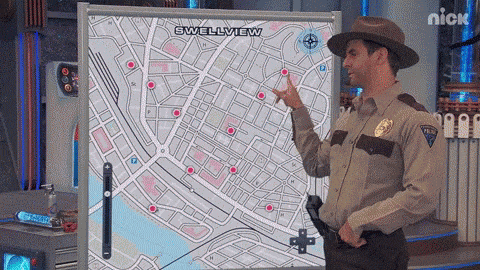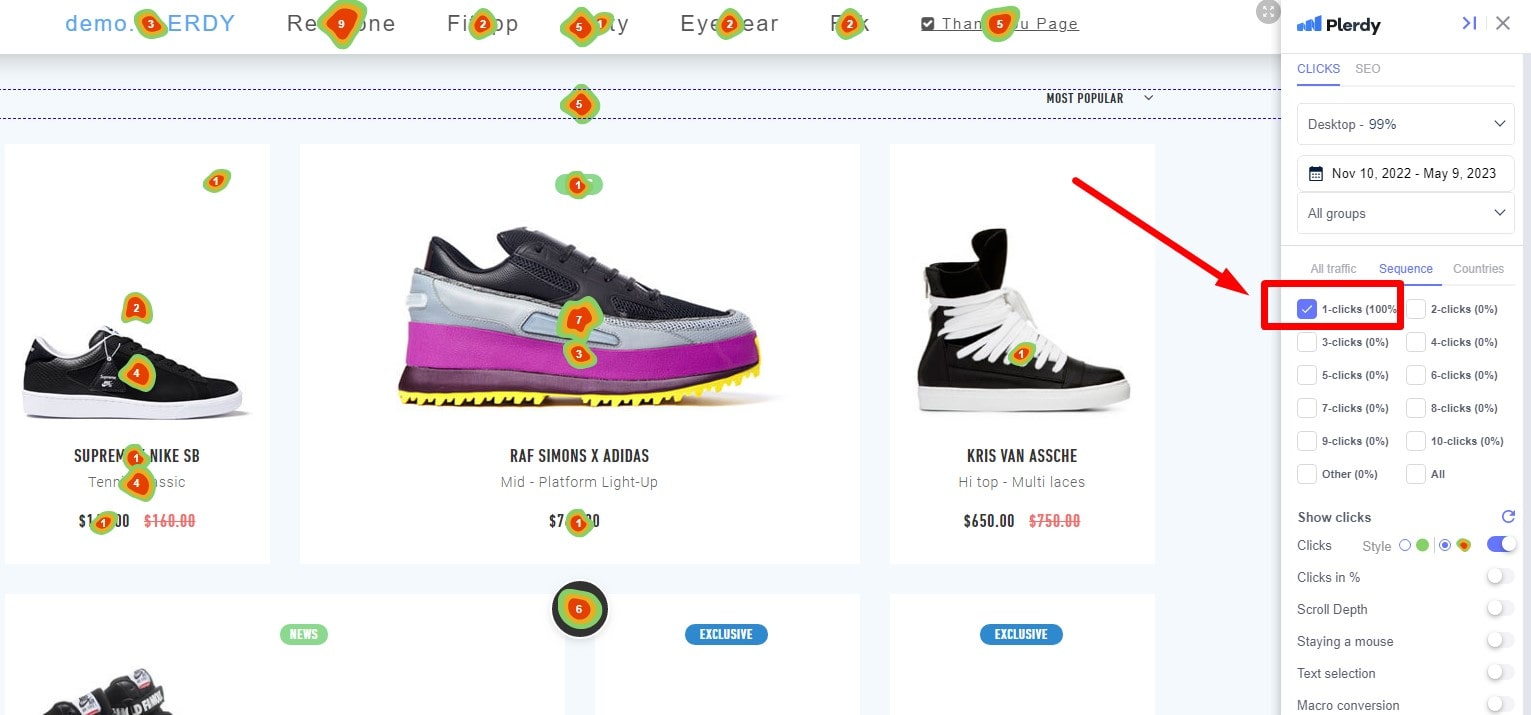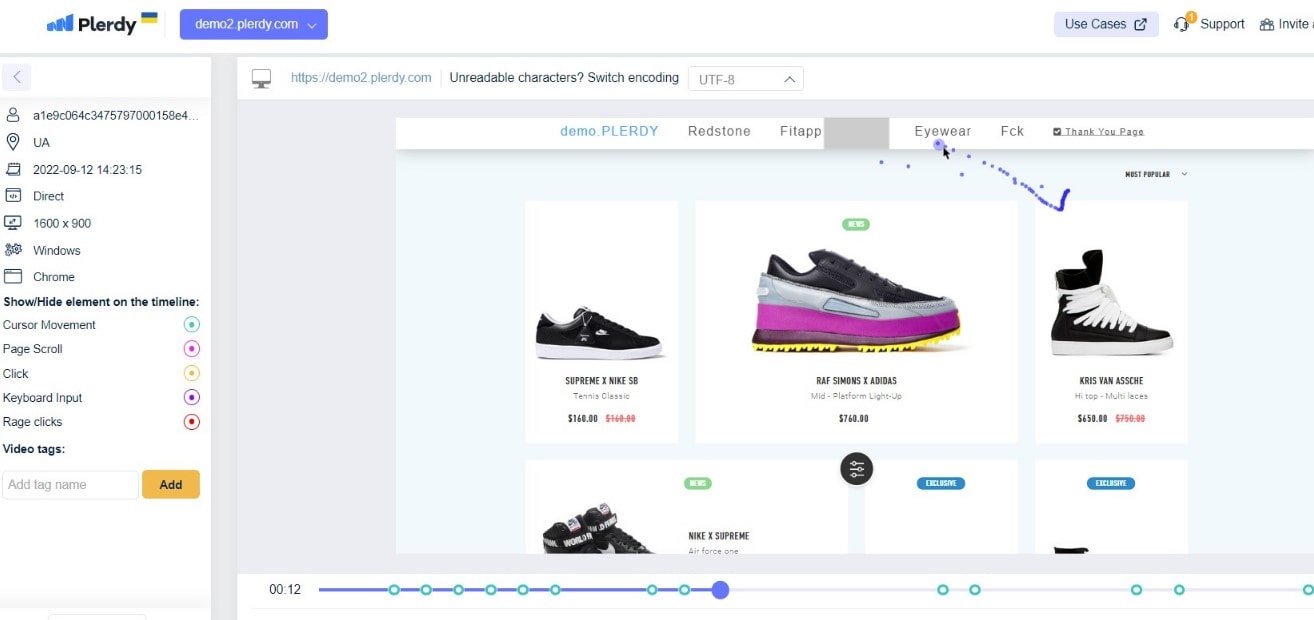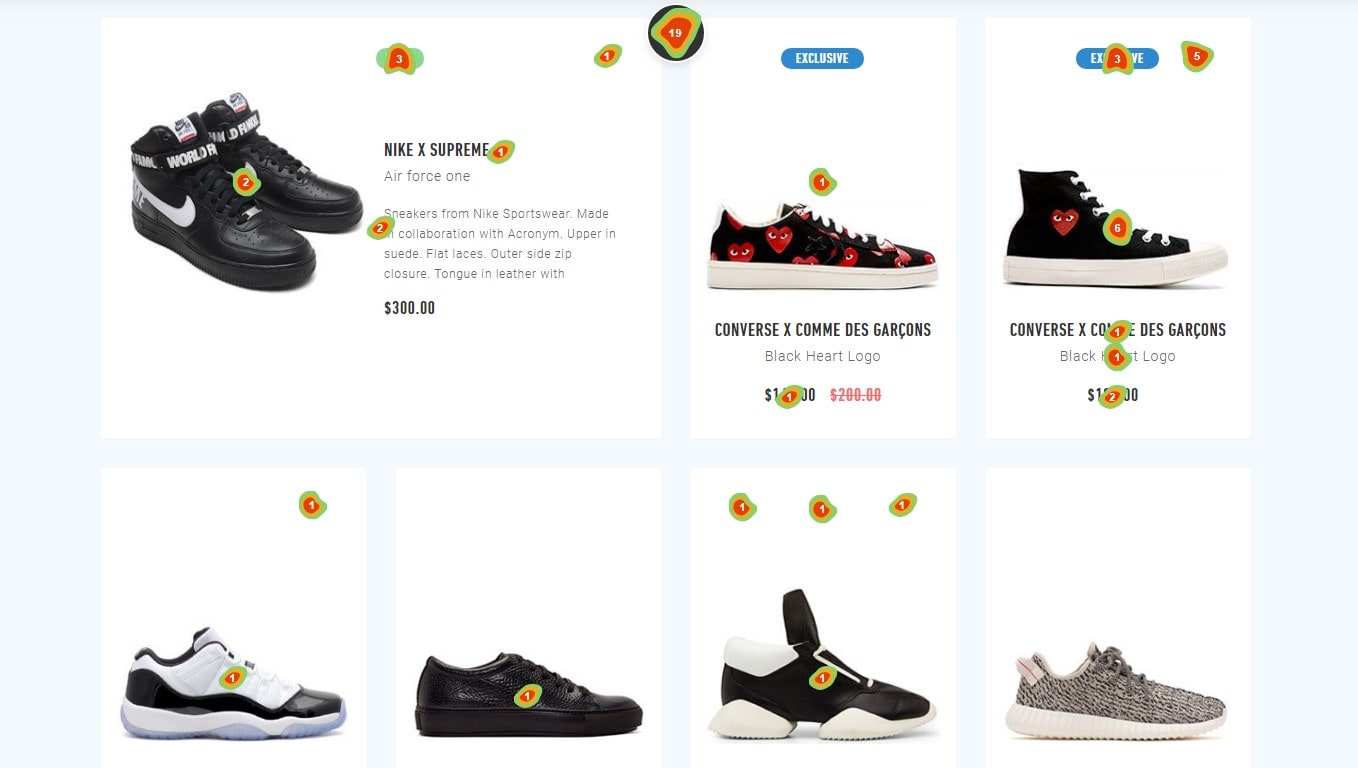A customer’s experience can be better understood by creating a user journey map. Like stepping into their shoes, you may better understand their relationships, feelings, and goals. This map is a narrative tool that shows the user’s path through your digital realm. Businesses may learn a lot from these paths since they show what and why people do things. Improved services, interfaces, and points of contact result from thorough comprehension. Central to this investigation is the map, a graphical representation of the user’s journey from the first interaction to the ultimate result. It is a manual for the intricacies of user experience. Upgrade your digital strategy with Plerdy, a state-of-the-art platform that analyzes site performance and user behavior, and make sure every experience is unforgettable.

The Components of a User Journey Map
Crafting a user journey map pivots around charting the customer’s course from initial contact to a fully realized outcome. This strategic blueprint dissects and displays key elements:
- Persona-driven narratives highlighting customer goals
- Brand-user touchpoints
- Emotional landscapes the user traverses at each stage
- Actionable insights that guide customer-centric decisions
The map illuminates the route for a SaaS customer from discovering the tool to becoming a power user. In e-commerce, it traces the shopper’s path through browsing, checkout, and post-purchase support. Each map is a tailored compass—guiding teams to refine every twist and turn of the customer journey, ensuring a seamless, satisfying user experience.
Personas: The Starting Point
In user journey mapping, personas anchor the narrative—vital signposts that ground the customer’s voyage. These profiles embody the typical user, sketched with precise details to humanize the map’s trajectory. Consider:
- Demographics shaping the user profile
- Behavioral patterns steering the customer’s course
- Motivations driving the user’s map engagement
For a tech enterprise, the persona might be an IT specialist seeking efficiency. An online retailer could zero in on a value-driven shopper navigating the purchase process. Tailoring the map to these personas ensures a customer-centric route—directing a journey that resonates with real user scenarios and fosters deep customer connections.
Stages of Interaction
Within a user journey map, we delineate distinct stages that capture the customer’s progressive interactions with the brand. These phases chronicle the user’s evolving engagement:
- Awareness, where the user first encounters the brand
- Consideration, as the customer weighs options
- Decision: when the user selects a product
- Retention, focusing on keeping the customer engaged
- Advocacy, where the satisfied customer recommends the brand
The journey may be tracked for a mobile app from download to regular usage. In healthcare, it charts the patient’s path from symptom search to treatment. Crafting this map with precision ensures a seamless, supportive user expedition—streamlining the customer’s path and enhancing satisfaction.
Touchpoints and Channels
In the architecture of a user journey map, touchpoints and channels are pivotal intersections where the customer interacts with the brand. These are the moments and mediums that can pivot a user’s path:
- Social media ads sparking initial interest
- Customer service calls for support inquiries
- In-app notifications enhance user engagement
- Checkout processes on e-commerce sites
For a fintech firm, touchpoints include app features or online banking services. A fashion retailer maps out fittings, purchases, and follow-ups. Strategically plotting these encounters on the map provides a framework for a robust customer narrative—paving the way for an intuitive, engaging user expedition through each chosen channel.
User Actions, Thoughts, and Emotions
User journey maps dive deep into the user’s psyche—capturing actions, thoughts, and emotions at each crossroad. This trio of insights forges a path that is:
- Clicking “Buy Now” with a sense of urgency
- Browsing products while feeling curious
- Comparing options with analytical care
- Experiencing satisfaction upon completing a transaction
Whether it’s a software user troubleshooting with determination or a bookstore visitor selecting a novel with anticipation, the map charts these inner experiences. Aligning the map’s course with real-life user narratives forges an empathetic blueprint, enabling brands to navigate and enhance the user’s journey with foresight and empathy.
Pain Points and Opportunities
Identifying pain points and opportunities within a user journey map is essential:
- Spotting where users encounter frustration to streamline the journey
- Seizing moments where user delight can be amplified
- Transforming user feedback into actionable improvements on the map
- Bridging gaps in the journey that present business opportunities
Pinpointing and resolving buffering issues for a streaming service can turn a pain point into a seamless user experience. An e-commerce site can capitalize on the opportunity to personalize recommendations, enhancing the user’s shopping journey. Each pain point addressed and opportunity taken enriches the user journey map, turning potential user dropoffs into paths of engagement and loyalty.
The Process of Creating a User Journey Map

Crafting a user journey map unfolds through a strategic series of steps tailored to weave the user’s narrative into the fabric of service design:
- Gathering data to echo the user’s authentic voice
- Sketching the user’s initial engagement with the brand
- Charting the milestones along the user’s path
- Integrating user feedback to fine-tune the map
This may involve tracking a user’s navigation through software interfaces in the tech sphere. For retail, it’s mapping the path from discovery to purchase. Each map distills complex user data into a visual storyline, guiding brands to elevate the user’s journey with precision and insight.
Research and Data Collection
Creating a user journey map requires extensive study and data collection:
- Conducting interviews to capture the user’s voice
- Analyzing behavior through user interaction logs
- Compiling feedback from surveys for authentic user sentiments
- Observing user behavior to pinpoint map waypoints
In healthcare, this might involve tracking patient appointments and treatment outcomes. For an app developer, it entails logging user clicks and navigation patterns. In this initial stage, user journey maps are data-driven and mirror actual user experiences, ensuring they resonate with the desired audience.
Identifying User Goals and Objectives
Pinpointing user goals and objectives is critical in sculpting a user journey map. This task lays the groundwork for a map that’s not just a path but a strategic guide:
- Decoding user aspirations to align the map’s direction
- Listing key objectives, users aim to accomplish
- Weaving in milestones to reflect user achievements
- Tailoring the journey’s flow to user-defined success criteria
In an e-commerce setting, this could mean charting a map from browsing to buying. For digital platforms, it’s guiding users from onboarding to regular engagement. Centering the map on user goals crafts a narrative that propels the journey forward—making every map a compass for user success.
Mapping the Journey Step by Step
Mapping the user journey step by step is a systematic process that plots a user’s interaction with the service or product. This granular approach breaks down the map into digestible segments:
- Outlining the start point where the user first engages
- Detailing each subsequent action and decision point
- Capturing moments of user hesitation or delight
- Recording the end goal or conversion point
Streaming account creation and content pleasure are related. A travel app’s map tracks users from search to booking. The step-by-step cartography makes the user journey map an actionable tool for user experience improvements.
Visualizing the Map for Clarity and Insight
Visualizing the user journey map provides clarity and insight, transforming abstract data into a tangible guide:
- Plotting user interactions in a visually intuitive format
- Highlighting key touchpoints with distinct visual markers
- Simplifying complex paths to enhance understanding
- Depicting emotions and experiences with color coding
For a travel app, this means showing the user’s path from destination search to booking with clear icons and flow lines. A healthcare provider may use visuals to depict patient flow through different care stages. This clear visualization ensures that the user journey map is not just a document but a strategic vision board, readily decipherable and actionable for all stakeholders.
Types of User Journey Maps

Diverse types of user journey maps cater to varying objectives and insights:
- Current State Maps chart the user’s present interaction, capturing real-time experiences.
- Future State Maps envision the user’s potential path, forecasting improvements.
- Day-in-the-Life Maps illustrate the user’s typical daily interactions beyond digital touchpoints.
- Service Blueprint Maps delve deeper, linking the user’s journey with back-end processes.
For instance, a bank may use Current State Maps to understand a user’s online banking experience, while a health app might employ Future State Maps to enhance patient care plans. Each map type offers unique lenses through which businesses can scrutinize and strategize the user journey.
Current State vs. Future State Maps
Current State Maps and Future State Maps serve as pivotal tools in user journey mapping, offering distinct perspectives on the user experience:
- Current State Maps capture the user’s journey, spotlighting immediate experiences and pain points.
- Future State Maps project the user’s path forward, pinpointing enhancements to elevate the journey.
Current State Maps track a user’s workout patterns for a fitness app, while Future State Maps might envision integration with nutrition tracking for a holistic health approach. The maps act as benchmarks and beacons—assessing today’s user experience and charting a course for a more intuitive, user-friendly map tomorrow.
Service Blueprints vs. Customer Journey Maps
Service Blueprints and Customer Journey Maps are two sides of the user experience coin, each offering valuable insights into the user’s interaction with a service or product:
- Service Blueprints dissect the operational aspects, spotlighting the mechanisms behind user interactions.
- Customer Journey Maps chart the user’s path through the service landscape, focusing on the emotional and experiential facets.
For a hotel, the Journey Map might illustrate a guest’s experience from booking to checkout, while the Service Blueprint would detail staff roles and backend processes that facilitate this journey. By juxtaposing these two maps, businesses gain a dual perspective—aligning the user’s journey with internal processes to refine the overall service delivery map.
Day in the Life vs. Scenario-based Maps
Day in the Life maps and Scenario-based maps offer nuanced snapshots of a user’s experience with a service or product:
- Day in the Life maps chronicle users’ daily interactions, revealing habitual touchpoints and routines.
- Scenario-based maps focus on specific user goals within a service, mapping out potential paths and outcomes.
For instance, a Day in the Life map for a busy parent might track their use of a time-management app throughout their day. In contrast, a Scenario-based map for the same user could explore the journey of planning a child’s birthday party using the app. Both map types enrich the understanding of the user’s journey, providing actionable insights to tailor the service map to real-world user scenarios.
Utilizing User Journey Maps for Business Strategy

Leveraging user journey maps informs business strategy by aligning customer needs with company offerings:
- Tailoring marketing efforts to target key points in the user’s path
- Streamlining service delivery to smooth out the user’s map
- Refining product features to enhance the user’s journey
- Shaping customer service protocols to address map insights
In retail, journey maps guide store layouts to match the shopper’s flow. For SaaS companies, maps drive interface tweaks to support the user’s navigation. Integrating journey maps into strategic planning ensures a user-focused approach, turning insights into actions that propel the business forward along the user’s map.
Enhancing Customer Experience
Enhancing customer experience is a pivotal goal of a well-crafted user journey map. It serves as a blueprint for the seamless user experience:
- Finding user friction areas to improve interaction
- Customizing touchpoints for a personalized user path
- Optimizing transitions between channels for a fluid user journey
- Measuring user satisfaction at key stages to refine the journey
In hospitality, journey maps guide guest experiences from booking to post-stay reviews. For e-commerce, they inform website design, ensuring easy navigation from landing page to checkout. By focusing on the user’s journey, businesses map out a course for continuous improvement, making each user’s path an opportunity to shine.
Identifying and Solving User Problems
User journey maps are indispensable tools for pinpointing and addressing user problems:
- Mapping out user pain points to target precise solutions
- Tracing the user’s steps to understand their challenges
- Adjusting the map’s route to bypass user frustrations
- Testing solutions within the map to ensure user satisfaction
This method identifies mobile app user dropoffs. Financial services use maps to simplify online banking, making the user’s path to transactions clearer. Each solution redefines the journey map, transforming user obstacles into gateways for innovation and cementing the map’s role in problem-solving.
Informing Content and Feature Development
User journey maps guide content and feature development with laser precision, ensuring that every addition enriches the user’s experience:
- Aligning content with user needs highlighted in the journey
- Crafting features that users seek at specific map points
- Tailoring updates to enhance the journey’s flow
- Gauging content effectiveness through user map feedback
In software development, this translates to building features that users encounter as they navigate complex tasks. For online publishers, it means curating articles that address user questions at the research phase of the journey. By mapping these elements, businesses can deliver content and features that users find valuable, directly feeding into a refined and intuitive user journey.
Driving Cross-functional Collaboration
User journey maps catalyze cross-functional collaboration, unifying teams around a common goal: optimizing the user’s path.
- Synthesizing insights from sales, marketing, and customer service onto one map
- Design and tech teams iterating features based on user feedback loops
- Content strategists craft messages that speak to each stage of the journey
In retail, such maps align store layout experts with digital teams to create a seamless shopping experience. In tech, they bring together UI/UX designers with developers to ensure the user’s digital map is intuitive. This collaborative approach ensures every department navigates toward a unified vision of the user journey.
Best Practices for Effective User Journey Maps
Effective user journey maps hinge on a set of best practices that ensure they accurately reflect the user’s experience:
- Involving real user data to ground the journey in reality
- Ensuring the map is clear and accessible for cross-team collaboration
- Regularly updating the map to reflect the evolving user landscape
- Using the map to foster empathy by visualizing the actual user experience
For a mobile app developer, this means integrating user testing feedback into the map. In healthcare, it involves charting a patient’s course through treatment, with input from caregivers. These practices transform the map into a dynamic tool, steering the user’s journey toward an optimal experience.
Inclusivity in User Representation
Embracing inclusivity in user representation is key to crafting a comprehensive user journey map.
- Reflecting diverse user groups to capture a broad spectrum of experiences
- Integrating varied user abilities to ensure accessibility within the journey
- Considering cultural nuances that influence user interaction with the map
- Including non-traditional user paths to account for all journey scenarios
For instance, in the digital banking sector, this approach involves designing maps that cater to tech-savvy users and those less familiar with digital services. In education, it means mapping journeys for traditional and non-traditional students alike. Inclusivity broadens the map’s horizon, enabling a journey considering every user’s path.
Balancing Detail with Overload
Striking the right balance between detail and information overload is crucial in user journey map creation:
- Distilling complex data into actionable insights without losing substance
- Highlighting critical touchpoints without cluttering the user’s path
- Focusing on stages that most impact the user’s journey
- Streamlining the map to maintain clarity while navigating the user experience
This might involve mapping critical in-game decision points without documenting every possible move in the gaming industry. For e-commerce, it’s about capturing the checkout process without detailing every product view. A map becomes a strategic asset when it drives the user’s journey with clarity and insight while avoiding complexity.
Iterative Approach to Journey Mapping
An iterative approach to journey mapping ensures that the user experience continuously evolves and improves:
- Regularly revisiting the user journey map for updates
- Refining map details as the user’s behaviors and preferences change
- Conducting ongoing user research to feed into the map’s evolution
- Testing new routes and touchpoints to enhance the user journey
In software development, this means evolving the map with each sprint and integrating user feedback. For hospitality, it’s about updating the guest’s journey map post-stay evaluations. This iterative cycle positions the map as a living document that adapts and grows in tandem with the user’s journey, guaranteeing relevance and effectiveness.
Aligning Business Objectives with User Needs
User journey maps excel in syncing business objectives with user needs:
- Ensuring business goals complement the user’s map milestones
- Harmonizing product roadmaps with insights from the user journey
- Aligning marketing strategies with the user’s decision-making process
- Adapting service offerings to match the user’s evolving journey
This means aligning software updates with user task flows for a SaaS company. Online retail is about shaping the shopping experience to match user expectations while meeting sales targets. This connection makes the user journey map a strategic combination of corporate growth and user satisfaction.
Case Studies: Success Stories and Lessons Learned
Case studies serve as compelling narratives that underscore the practical application of user journey maps:
- Illustrating how mapping the user journey led to a revamp of a shopping app, boosting sales
- Detailing the way a user map informed a healthcare portal’s redesign, improving patient satisfaction
- Chronicling a software’s user journey overhaul that resulted in increased user retention
- Sharing how subtle tweaks to a travel booking site’s map enhanced user flow and conversion rates
Each case study spotlights the pivotal role of the user journey map in driving product evolution, showcasing tangible benefits while extracting lessons learned for continuous refinement of the mapping process.
Example of a Successful User Journey Map Implementation
A standout instance of user journey map implementation comes from an e-commerce platform specializing in artisanal goods:
- Mapping the user’s search and discovery process to optimize navigation
- Streamlining the checkout journey, reducing cart abandonment
- Enhancing post-purchase communication, which amplified user satisfaction and repeat business
- Integrating user feedback mechanisms to refine the map iteratively
This deliberate mapping led to a tailored shopping experience, where users effortlessly transitioned from browsers to buyers. The company witnessed a marked uptick in user engagement, with a notable decrease in support tickets—a testament to the journey map’s impact. This case exemplifies how a well-executed user journey map can orchestrate a transformative user experience.
Learning from Failed User Journey Mapping Attempts
Failed user journey mapping attempts offer valuable lessons:
- Recognizing the importance of accurate user data to inform the map
- Understanding that overcomplicating the map can obscure user needs
- Learning that a map must be flexible to adapt to unexpected user behavior
- Acknowledging that constant user engagement is vital for map validation
A financial tech startup’s journey map failed when it overlooked the diversity of its user base, leading to a one-size-fits-all interface that frustrated users. By reassessing their journey map to incorporate varied user financial habits, they created a more personalized experience. Failures like these highlight the need for a dynamic user journey map—responsive to real user feedback and agile enough to evolve.
Key Takeaways for Businesses and Designers
For businesses and designers, the construction and application of a user journey map offer pivotal takeaways:
- User journey maps must stem from authentic user data to be truly reflective.
- A map’s value lies in its use as a collaborative tool across functions.
- Successful maps balance comprehensive detail with user-centric simplicity.
- Iterative refinement is crucial—user maps should evolve with the user’s needs.
- The most effective maps drive both strategic vision and tactical design decisions.
These insights could lead to more intuitive software interfaces in a tech firm. For a retail brand, they ensure that the in-store experience aligns with online shopping habits. Adopting these principles, designers can craft a user journey map that serves as a compass, directing toward enhanced user experiences and strategic business outcomes.
Conclusion
In the tapestry of digital marketing, user journey mapping stands out as a masterstroke. It’s the art of plotting a user’s course through your digital landscape – a journey that’s as unique as the individual. User experiences are connected on each map, with important tips and feelings highlighted. A journey into the user’s thoughts and feelings, this map shows how to make the user’s experience better.
Consider the journey of a user in the e-commerce sector:
- An engaging ad sparked initial curiosity.
- Navigating through the intuitive website layout.
- The ease of finding desired products.
- Smooth checkout and payment process.
- Post-purchase follow-up and customer service interactions.
This trip map is a strategic tool that clarifies and focuses. It finds and fixes user experience gaps for a smooth journey. User feedback and analytics update the map.
User journey mapping navigates enterprises toward a user-centric digital environment. Understanding and optimizing the user experience makes each journey memorable. The map must change with user demands and behaviors to ensure success. Organizations may make every user’s journey a destination by mastering this art.
